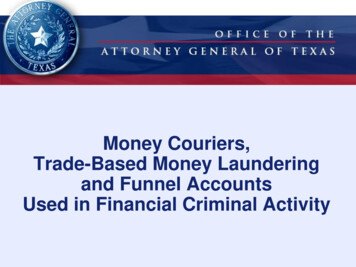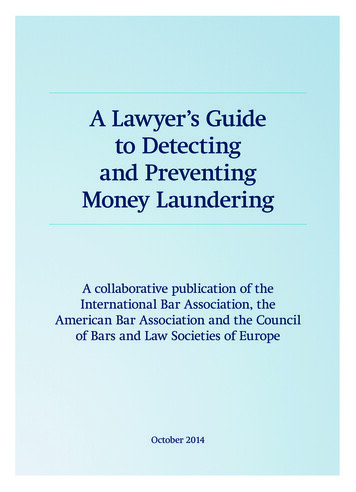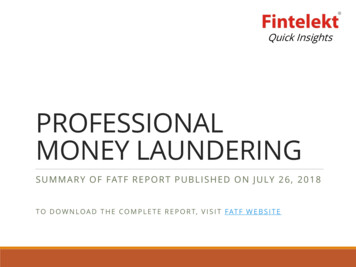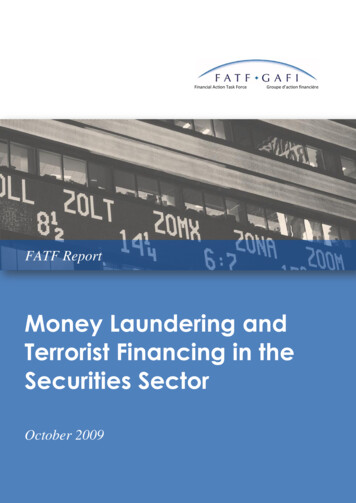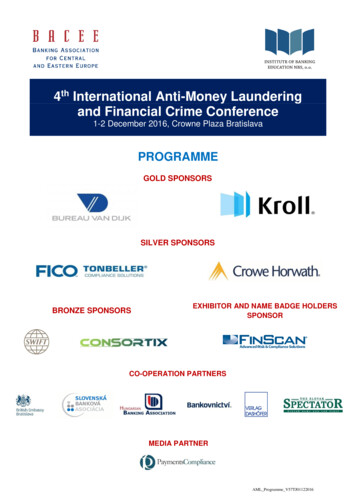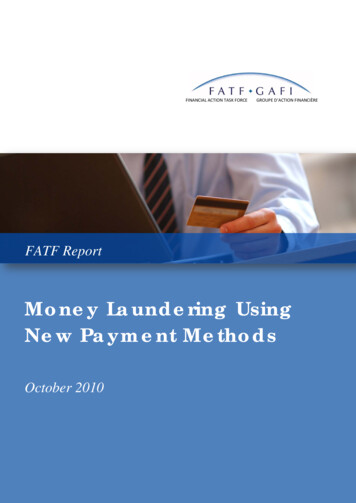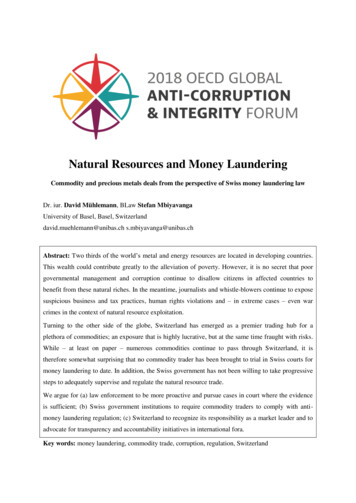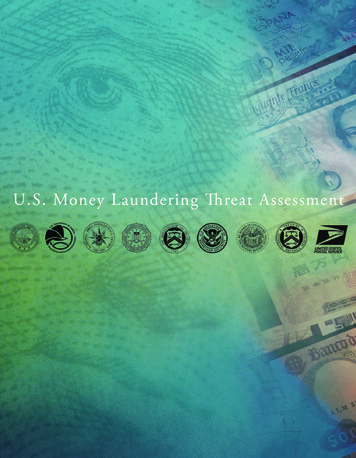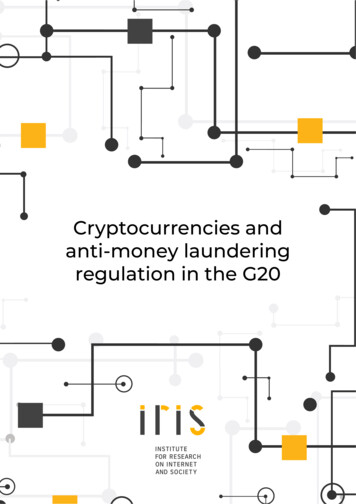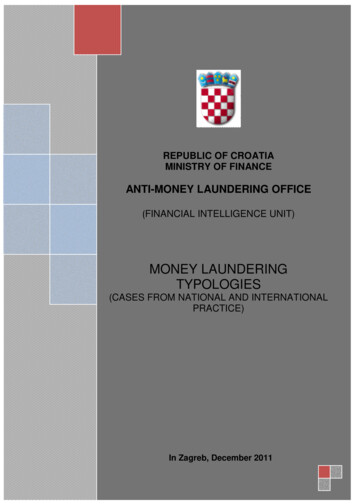
Transcription
REPUBLIC OF CROATIAMINISTRY OF FINANCEANTI-MONEY LAUNDERING OFFICE(FINANCIAL INTELLIGENCE UNIT)MONEY LAUNDERINGTYPOLOGIES(CASES FROM NATIONAL AND INTERNATIONALPRACTICE)In Zagreb, December 20111
C O N T E N OMNATIONALPRACTICE2.1.Fictitious invoicing2.1.1. Case 12.1.2. Case 22.2.Activities involving non-residents 12.2.1. Case 12.3.Activities involving non-residents 22.3.1. Case 12.4.Abuse of narcotic drugs2.4.1. Case 12.4.2. Case 22.5.Usury (Shark Loan Contracts)2.5.1. Case 12.6.Trafficking in human beings and illegal trade of human beings2.6.1. Case 12.7.Fraud involving foreign currency trading on the FX market2.7.1. Case 12.7.2. Case 22.8.Lines of credit2.8.1. Case 12.9.Professional activities2.9.1. Case 12.9.2. Case 2MONEY LAUNDERING CASES – EXAMPLES FROM THENATIONAL PRACTICEThe case of LTD. How the Croatian financial-intelligence unit (AMLO)3.1.solves the cases of suspicion of money laundering3.2.Case: Suspicious transactions from offshore zones related to creditoperations3.3.The case of GERMANY3.4.The case of FINANCIAL INSTITUTION3.5.The case of PEPS3.6.The case of MONEY REMITTANCE3.7.The case of CASH3.8.Case: Suspicious activities – an attempt to open an account3.9.Case: Suspicious international transactions related to acquisition of anownership stake3.10. The case of TAX EVASION3.11. The case of GRAZ83.4.THE CASES FROM MONEY LAUNDERING TYPOLOGIES FROMINTERNATIONAL PRACTICE4.1.Cases involving designated non-financial businesses and professions4.1.1.Example 28303132343536383939392
4.2.4.3.4.4.4.1.2.Example 24.1.3.Example 34.1.4.Example 44.1.5.Example 54.1.6.Example 6Cases related to insurance sector4.2.1.Example 14.2.2.Example 2Cases related to securities sector4.3.1.Example 14.3.2.Example 24.3.3.Example 3Cases related to non-financial sector4.4.1.Example 14.4.2.Example 24.4.3.Example 3404142434445454647474849505051523
1. INTRODUCTIONUnder Art. 66(4) of the Anti-Money Laundering and Counter Terrorism Financing Act(Official Gazette No. 87/08) (hereinafter: the Act), the Anti-Money Laundering Office(hereinafter: the AMLO) disseminates or discloses to the reporting entities listed in Art. 4(2)of the Act who have an obligation to implement the anti-money laundering and counterterrorism financing measures (hereinafter: the Reporting Entities) any information regardingthe current money laundering and terrorism financing techniques, methods, trends andtypologies.In the context of anti-money laundering and counter terrorism financing, typology isdefined as a systematic classification or breakdown of money laundering methods, techniquesand trends observed over a given period of time, which share multiple common characteristicsor features.The purpose of this document on typologies and cases is to assist the ReportingEntities and supervisory authorities in their respective roles, as stipulated by law, inconnection with the implementation of measures and activities aimed at prevention anddetection of money laundering and terrorism financing, to the law enforcement authorities andother relevant state bodies, and to raise the awareness on the ML/TF risks and vulnerabilitiesof certain sectors irrespectively of whether they are related to the placement, layering orintegration of illegal proceeds.This document, using examples of typologies or methods, techniques and trends, aswell as using de-identified actual cases from international practice, has been designed toillustrate suspicious transactions that are related to money laundering methods and indicatorslinked to individual cases, in order to help improve the understanding of potential risks facedby different sectors, independent professions and businesses, and thus help prevent and detectsome of the many methods used in order to conceal the origin of criminal proceeds in theRepublic of Croatia and worldwide.The document describes and presents the typologies and cases from the nationalpractice which are the result of strategic analyses conducted by the AMLO within the scope ofits obligations and competencies as stipulated in the Act, as well as the examples of casesfrom international practice that have been taken from the materials found in the periodicalFATF1 reports, whose opinion is that the typologies have a key role in the process underwhich this international body, whose mission and purpose are precisely the development andpromotion of policies, both on the national and international level, and establishing ofinternational standards of anti-money laundering and counter terrorism financing, establishesthe standards. The examples presented herein describe and illustrate how the frameworkintended for legal activities and financial channels was misused for money launderingpurposes.1Financial Action Task Force (FATF) is an international body established at the meeting of G-7 countries in Paris in 1989,whose mission is to establish international standards and develop anti-money laundering and counter terrorism financing.4
Below you will find an overview of the examples of money laundering typologies, andthe examples of actual cases from the national and international practice, intended for allReporting Entities, supervisory bodies from Art. 83 of the Act and other state bodies fromArt. 58 of the Act.Definition of money laundering:Money laundering means undertaking activities through multiple transactions aimed atconcealing the actual origin of funds or other assets suspected of being generated by illegalactivities either in the country or internationally, in order to present such funds or assets asbeing obtained legally.Money laundering is an international phenomenon, and techniques used in connectiontherewith are diverse and sometimes quite sophisticated. New payment techniques (ebanking) and international diversity of financial markets in certain jurisdictions, anddevelopment of new financial products, go hand in hand with and render possibledevelopment of new techniques aimed at concealing the true origin of the funds, i.e. of moneylaundering and terrorism financing.The main purpose of this process is to convert illegal proceeds into some other form ofassets in order to conceal their illegal source. Money laudering therefore means convertingillegal proceeds into seemingly legal ones. Criminal offenders thus increase their income, andavoid prosecution and confiscation of illegally obtained assets.Money laundering cycle:Placement, layering and integration are the three stages of the money laundering process.The placement stage is the moment when dirty money is being placed or introducedinto the financial system and, using different methods and techniques, separated and distancedfrom its true, illegal source. In this stage of the process, money launderers bring the illegalproceeds into the light of day, so this is also the stage when it is easiest to detect and stopthem.The layering stage comprises the process under which the funds circulate within thefinancial systems, being moved from one account into another, from one form into another,from one jurisdiction into another. It represents an activity aimed at channeling the fundsplaced in a financial system, through complex financial transactions, in order to conceal andcover the trail and source of dirty money.The integration stage is the final stage of the money laundering cycle, as a processunder which legal funds are integrated (comingled) with the illegal funds. If the fundsobtained by criminal activities have been successfully placed into financial channels and, inthe layering stage, distanced from their illegal source, they are then reintegrated into legalfinancial flows.5
Rationale for existence of the anti-money laundering measures:Taking advantage of economic and financial globalization, and the constant advances intechnologies and communications in response to the demand by all participants in the globaleconomic and financial market, criminal offenders transfer illegal proceeds across stateborders. They use intensely a broad spectrum of new and ever more sophisticated techniquesto transfer funds from one country into another, whereby the transactions move at anelectronic speed from the national into the global environment, or misuse legal persons, eitherreal or fictitious, in order to conceal the identity of the beneficial owner of the illegallyobtained funds.Money laundering thus became a global phenomenon, which undermines internationalefforts aimed at creating a free and competitive market and prevents economic developmentof national economies.National economies are very vulnerable in that respect. Money laundering threatens thefinancial sector and stability of financial institutions, with important economic and socialimplications. Revenue generated by illegal activities give their perpetrators great economicpower over the economies of such countries, making a healthy economic growth a goal that isalmost impossible to achieve because the only interest of the criminal groups is to protecttheir own assets.As the countries create their own anti-money laundering systems and measures, personsinvolved in illegal activities that generate illegal proceeds are forced to look for jurisdictionswhere such measures are weak or non-existent. Therefore, an efficient anti-money launderingframework is an important factor in the domestic and international outlook for all countriesbecause it is precisely due the lack or absence of defined anti-money laundering and counterterrorism financing mechanisms and systems that the perpetrators are given an opportunity tolaunder their illegally obtained assets.Anti-money laundering and counter terrorism financing system in the Republic ofCroatia:Under the Act and the international standards, the anti-money laundering and counterterrorism financing system does not fall under the competence of a single institution; quitethe contrary, it is a system where the law clearly stipulates the roles of all participants andtheir mutual interaction and cooperation.As a financial intelligence unit, the AMLO is only a link in the anti-moneylaundering and counter terrorism financing chain, which can give its full contribution interms of preventing the abuse of the financial system of the Republic of Croatia formoney laundering and terrorism financing purposes only in an interactive collaborationwith other national competent authorities (State Attorney's Office, Office forSuppression of Corruption and Organized Crime, Ministry of Interior, Security andIntelligence Agency, Croatian National Bank, Croatian Agency for Supervision ofFinancial Services and the supervisory services of the Ministry of Finance) and foreignfinancial intelligence units.The AMLO, as the central national unit which collects from banks and other ReportingEntities information on transactions linked with money laundering and/or terrorism financing,6
conducts the analyses of transaction reports in order to confirm or reject the suspicion ofmoney laundering and terrorism financing, and notifies the competent bodies of any cases ofsuspected money laundering and/or terrorism NEYLAUNDERINGOFFICE(FINANCIALINTELLIGENCE UNITOF RH)- RECEIVING SUSPICIOUSTRANSACTION REPORTS- ANALYTICALINTELLIGENCPROCESSING OFSUSPICIOUSTRANSACTIONS- NOTIFYING COMPETENTBODIES OF CASESSUSPECTED OF ML/TF- INTERINSTITUTIONALCOOPERATION- INTERNATIONALCOOPERATIONNOTIFICATION OF CASES OF SUSPECTEDML/TF- banks- insurancecompanies- brokers- casinos- lawyers- notaries public- računovođe i dr.NOTIFICATIONS OFML/CT PORTSThe AMLO is therefore an intermediary between on the one hand the financial andnon-financial sectors (banks and other), which report the suspicious transactions to theAMLO, and on the other of the law enforcement authorities, as presented in the chart below:SUPERVISORYBODIES- FINANCIAL INSPECT- TAX ADMINISTRAT.- CUSTOMSADMINISTRATION- CNB- HANFALAWENFORCEMENTLAWENFORCEMENTAND OTHERBODIES- Ministry of Interior- State Attorney'sOffice- USKOK- SOA – SECURITYANDINTELLIGENCEAGENCY7
2. MONEY LAUNDERING TYPOLOGIES – EXAMPLESFROM THE NATIONAL PRACTICE2.1. FICTITIOUS INVOICING2.1.1. EXAMPLE 1:A foreign company invoices its services (consultancy, marketing, IT etc.) to a domesticcompany. There is a suspicion that the services in question have not been rendered at all. Thedomestic company pays the invoice by making a wire transfer abroad. The value of theinvoice is recognized as cost in the domestic company's business books, thus diminishing thetax base for calculation of tax, and moreover, the domestic and the international company arerelated to each other through ownership links (for instance, the founders/directors/owners ofthe domestic company are at the same time the founders/directors/owners of the internationalcompany).Grounds for suspicion: wire transfers to accounts abroad based on an invoice for services thatare suspected of being fictitious.Possible link with predicate crimes: tax evasion.8
2.1.2. EXAMPLE 2:A foreign company registered in an offshore financial center invoices a domestic companyfor the services rendered (consultancy, marketing, IT). The domestic company makes apayment by wiring the money abroad, to a bank account held by the same offshore companywith a bank in a neighbouring country or another country located within a convenientdistance.The invoice sent by the foreign offshore company is recognized as cost in the business booksof the domestic legal person (thus diminishing the tax base). The two companies are related,by virtue of their having ownership ties, and the transferred funds are withdrawn abroad incash, debiting the non-resident account opened abroad. The same funds are then brought intothe Republic of Croatia without being declared at the state border crossing, to be subsequentlyused for buying real estate and movables
Placement, layering and integration are the three stages of the money laundering process. The placement stage is the moment when dirty money is being placed or introduced into the financial system and, using different methods and techniques, separated and distanced
